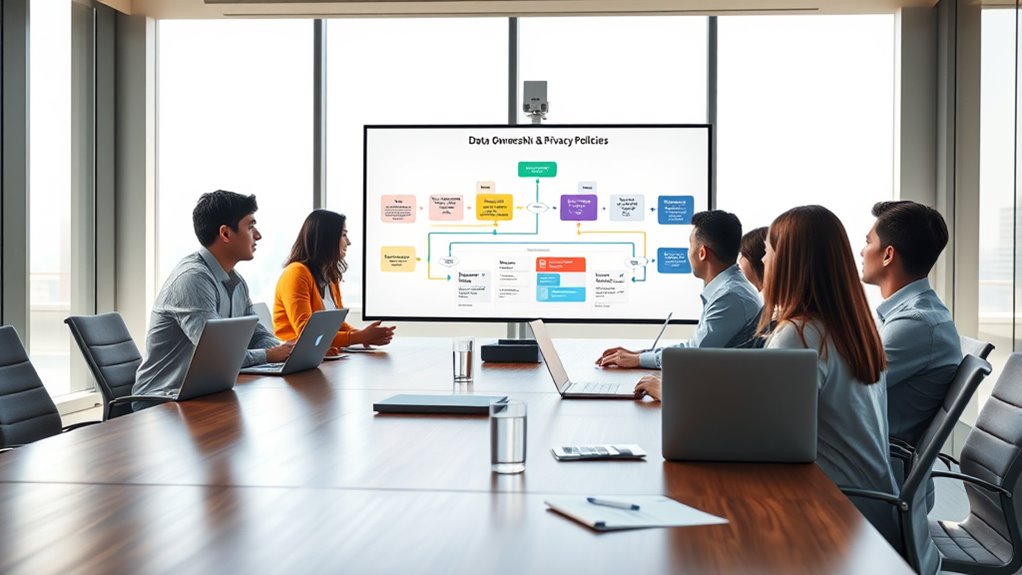To future-proof your ESP contract in a fast-changing market, prioritize flexible clauses that allow easy updates and amendments. Incorporate scalable pricing models and clear terms for system compatibility and upgrades. Stay ahead by including provisions for evolving regulations and data privacy standards. Regularly review and negotiate key terms to adapt to industry trends. If you’d like to know more about building resilient contracts, there’s valuable insights ahead to help you stay protected.
Key Takeaways
- Incorporate adaptive clauses that allow contract modifications in response to technological and market changes.
- Regularly review and update contractual language to reflect evolving industry standards and regulations.
- Include flexible termination and dispute resolution provisions to mitigate risks from unforeseen disruptions.
- Define clear performance metrics and review processes to ensure ongoing service relevance and quality.
- Build scalability and compatibility standards into the contract to support future system upgrades and integrations.
Assessing Flexibility in Contract Terms

When reviewing your ESP contract, adapting to changing needs is essential to evaluate how flexible the terms are. Check if the contract allows for smooth contract termination if your requirements shift unexpectedly. Flexible termination clauses give you the power to exit without heavy penalties, preventing long-term commitments that no longer serve your goals. Also, assess the dispute resolution process—clear, efficient procedures help resolve conflicts quickly and avoid costly legal battles. A flexible contract should specify how disputes are handled, ideally through mediation or arbitration, to save time and preserve relationships. Being proactive about these elements ensures your agreement can adapt as your needs evolve, minimizing risks and keeping your communication platform aligned with your business trajectory. Recognizing the importance of emotional support can also help you manage the stress of contractual negotiations and foster better relationships with your partners.
Incorporating Scalable Pricing Structures

Implementing scalable pricing structures guarantees your email service provider can grow with your needs. Tiered pricing models offer flexibility as your volume increases, while usage-based options let you pay only for what you use. These approaches help you manage costs effectively, no matter how your email demands evolve. Regularly reviewing your usage tracking ensures your pricing structure remains aligned with your actual needs and prevents overpaying.
Tiered Pricing Models
Tiered pricing models offer a flexible way to align your ESP costs with your evolving needs, allowing you to pay for only what you use. This structure often features dynamic pricing, adjusting costs as your email volume changes. It also includes tiered discounts, rewarding higher volume commitments with lower rates. You can forecast expenses better and avoid overpaying during slow periods. Additionally, understanding cost efficiency can help optimize your messaging budget and maximize return on investment. Here’s a typical tiered pricing example:
| Volume Range | Price per Email | Discount Rate |
|---|---|---|
| 0-10,000 | $0.01 | 0% |
| 10,001-50,000 | $0.009 | 10% |
| 50,001-100,000 | $0.008 | 20% |
| 100,001+ | $0.007 | 30% |
Usage-Based Flexibility
Usage-based flexibility allows you to adjust your email service provider costs directly in line with your actual email volume, giving you greater control over expenses. This scalable pricing structure offers subscription flexibility, so you pay only for what you use, helping you stay agile in a dynamic market. It also simplifies contract renewal, as you can modify your plan based on your evolving needs without long-term commitments. To maximize benefits, consider:
- Monitoring your email volume regularly to optimize costs
- Negotiating terms that allow for easy adjustments during contract renewal
- Combining usage-based options with other flexible pricing models for a tailored approach
With usage-based flexibility, you can future-proof your ESP contract, ensuring it adapts seamlessly as your email demands grow or shrink. Regularly reviewing your plan can help prevent overheating risks and ensure compliance with safety guidelines as your email traffic fluctuates.
Embedding Technology Compatibility and Integration Clauses

Including clear compatibility standards and seamless integration requirements in your contract guarantees your ESP can work effectively with your existing and future systems. You need to specify technical specifications so both parties understand what is needed for smooth operation. This proactive approach minimizes disruptions and keeps your marketing efforts running without interruption. Additionally, understanding industry transformations like AI automation can help you anticipate future technical needs and ensure your contract remains relevant over time.
Compatibility Standards Specification
To guarantee your ESP contract remains adaptable as technology evolves, embedding clear Compatibility Standards Specifications is essential. These standards ensure your platform can incorporate innovative features and adapt to market trends seamlessly. By specifying supported protocols, data formats, and integration frameworks, you reduce future friction. Additionally, considering store hours and operation trends can help tailor customer engagement strategies to evolving consumer behaviors and preferences. This approach safeguards your investment, minimizes upgrade costs, and maintains competitiveness. Clear standards make it easier for both parties to navigate updates, ensuring your ESP stays aligned with technological advancements and customer expectations over time.
Seamless Integration Requirements
Embedding clear integration clauses in your ESP contract is crucial to guarantee smooth and reliable interoperability with existing and future technologies. These clauses should specify vendor transparency regarding compatibility with current systems and upcoming innovations, reducing surprises during integration. By clearly defining technology standards and protocols, you ensure seamless communication between platforms, avoiding costly delays or disruptions. Including detailed requirements for ongoing updates and support helps maintain compatibility over time. Additionally, address how integration impacts contract renewal, ensuring that new features or changes don’t hinder performance or require renegotiation. Transparent language encourages collaboration, minimizes misunderstandings, and future-proofs your investment. Incorporating technology standards into the contract ensures consistent adherence to industry benchmarks, facilitating easier integration. Ultimately, well-drafted integration clauses create a foundation for continuous, reliable operation in a rapidly evolving digital landscape.
Including Provisions for Regulatory and Compliance Changes

Given how quickly regulations can change, it’s essential to incorporate provisions that address future compliance updates into your ESP contract. Doing so guarantees you can adapt without risking penalties or service disruptions. You should include clauses that specify how updates to laws or industry standards are handled, such as:
Anticipate regulatory changes by including compliance update clauses in your ESP contract to ensure ongoing smooth operations.
- Procedures for implementing new compliance requirements
- Conditions for contract termination if updates become unmanageable
- Clear dispute resolution processes related to regulatory disagreements
These provisions help protect your organization from unexpected legal issues and ensure smooth operations. They also clarify responsibilities if compliance standards shift, minimizing disagreements and costly disputes. By proactively addressing these areas, you future-proof your contract against regulatory surprises and safeguard your ongoing relationship with the ESP. Incorporating knowledge of regulatory and industry standards helps ensure your contract remains aligned with evolving legal requirements.
Defining Clear Data Ownership and Privacy Policies

As regulatory and compliance requirements evolve, it’s equally important to clarify who owns and controls the data collected through your ESP contract. You need clear policies on data ownership, privacy, and user consent to avoid disputes and ensure legal compliance. Define who holds rights to the data, how it’s stored, and who can access it. Incorporate data encryption to protect sensitive information and ensure user consent is explicitly obtained and documented. Use the table below to understand key elements:
| Element | Purpose | Best Practice |
|---|---|---|
| Data Ownership | Clarifies rights over collected data | Specify ownership in contract |
| Data Privacy | Protects user information | Implement privacy policies |
| User Consent | Legitimizes data collection | Obtain explicit, documented consent |
Additionally, understanding raw food principles can help in designing processes that prioritize safety and proper handling of sensitive information.
Establishing Performance Metrics and Service Level Agreements

To guarantee your ESP contract meets your needs, you need to establish clear performance metrics and realistic service level agreements. Setting precise targets helps track success and holds providers accountable. Regular performance reviews keep expectations aligned and allow for adjustments as your needs evolve. Incorporating consistent practice in your evaluation process ensures ongoing improvement and adaptability over time.
Define Clear Metrics
Establishing clear performance metrics and service level agreements (SLAs) is essential for ensuring your ESP contract delivers measurable results. Without precise benchmarks, evaluating the success of your provider becomes difficult, affecting contract renewal strategies and vendor evaluation. To set effective metrics, focus on key areas like deliverability rates, open and click-through rates, and response times. Clearly defined metrics help you monitor performance objectively and identify issues early. Consider including targets for email deliverability, list growth, and campaign responsiveness. Regularly reviewing these metrics allows you to adapt your contract terms as needed, ensuring your provider continues to meet evolving needs. Ultimately, defining clear metrics provides a solid foundation for long-term partnership success and keeps your email marketing strategy agile.
Set Realistic SLAs
Setting realistic SLAs is crucial for aligning your expectations with your ESP provider’s capabilities. When establishing these agreements, consider factors like cloud security measures and the provider’s ability to adapt to evolving threats. Clear, achievable targets help prevent misunderstandings and ensure consistent performance. In vendor management, setting practical SLAs fosters trust and accountability, reducing risks of service disruptions. Be specific about response times, uptime, and data protection standards, especially given the importance of cloud security in today’s environment. Avoid overly ambitious metrics that may strain your provider or lead to unmet expectations. Instead, base SLAs on current capabilities, allowing room for growth and improvement. This approach ensures your ESP partnership remains resilient amid market changes and technological advances.
Regular Performance Reviews
Regular performance reviews are essential for assuring your ESP provider meets agreed-upon standards and adapts to changing needs. By setting clear metrics and conducting regular assessments, you can identify issues early and adjust your contract renewal strategies accordingly. This proactive approach enhances vendor relationship management and keeps your email marketing aligned with your goals. During reviews, focus on:
- Tracking key performance indicators (KPIs) to measure success
- Ensuring compliance with SLAs and contractual obligations
- Addressing any service gaps or inefficiencies promptly
These reviews keep communication open, foster accountability, and help you stay agile in a dynamic market. Regular check-ins ensure your ESP contract remains relevant, flexible, and positioned for future growth.
Negotiating Amendment and Renewal Processes

Have you considered how to streamline the modification and renewal processes to protect your interests? Clear procedures help you adapt to market changes and avoid surprises. Use well-defined contract renewal strategies and vendor negotiation tactics to secure favorable terms. Establish deadlines, notice periods, and escalation steps upfront. This ensures timely discussions and minimizes disruptions. Consider including flexibility clauses for amendments, allowing adjustments without extensive renegotiations. To clarify, here’s a quick comparison:
| Aspect | Importance |
|---|---|
| Timing | Prevents last-minute surprises |
| Flexibility | Enables adaptation to future changes |
| Negotiation Tactics | Strengthens your position during renewals |
| Amendment Process | Ensures smooth updates to the contract |
Planning for Feature Updates and System Upgrades

Planning for feature updates and system upgrades is essential to keep your ESP current and competitive. Regular updates improve user experience, ensuring your platform remains intuitive and efficient. It also helps you stay ahead of industry changes and evolving customer expectations. When negotiating your contract, consider clauses that specify update schedules, upgrade processes, and vendor management responsibilities. This proactive approach minimizes disruptions and ensures seamless integration. To deepen your strategy, focus on:
- Clear timelines for feature releases and system upgrades
- Flexibility for customizations based on your evolving needs
- Vendor commitments to ongoing improvements and support
Anticipating these updates helps you adapt swiftly, maintain a positive user experience, and establish a reliable partnership with your vendor. This proactive planning is key to future-proofing your ESP investment.
Ensuring Support for Market and Industry Trends

Staying aligned with market and industry trends is essential to guaranteeing your ESP remains relevant and competitive. Incorporate regular market trend analysis into your contract to adapt quickly to changing customer preferences and emerging technologies. This proactive approach helps you stay ahead of competitors and meet evolving customer expectations. Additionally, ensure your contract emphasizes support for industry-specific compliance standards, which can vary across sectors. Clear clauses should specify how updates and system modifications address regulatory changes and industry best practices. By embedding flexibility for ongoing trend adaptation and compliance, your ESP contract becomes a dynamic tool that safeguards your investment and positions your business for long-term success in a rapidly shifting landscape.
Engaging Legal and Industry Experts in Contract Drafting

Engaging legal and industry experts during contract drafting guarantees your ESP agreement accurately reflects current regulations and best practices. Their insights guarantee your contract navigates complex issues like compliance, data protection, and evolving industry standards, reducing legal risks. Experts can help you identify potential pitfalls in contract negotiation and strengthen clauses for effective risk mitigation.
Consider these benefits:
- Ensuring clarity and enforceability of key terms
- Incorporating industry-specific regulatory updates
- Anticipating market shifts and future challenges
Frequently Asked Questions
How Can I Identify Potential Future Market Shifts Affecting My ESP Contract?
To identify potential future market shifts affecting your ESP contract, you should regularly conduct market trend analysis to spot emerging patterns early. Combine this with competitive intelligence to understand what competitors are doing and anticipate changes. Stay connected with industry news, attend conferences, and monitor regulatory updates. This proactive approach helps you recognize early signals of market shifts, enabling you to adapt your contract strategies accordingly.
What Are Common Pitfalls When Negotiating Flexible Contract Terms?
When negotiating flexible contract terms, watch out for common pitfalls like contract ambiguities that can lead to misunderstandings later. Avoid agreeing to rigid pricing structures that limit your ability to adapt to market changes. Guarantee the contract clearly defines terms and includes provisions for adjustments. By addressing these issues upfront, you protect yourself from unexpected costs or disputes as market conditions evolve.
How Do I Ensure My ESP Contract Remains Compliant With Emerging Regulations?
Think of your contract as a ship steering through shifting tides. To stay compliant with emerging regulations, you should stay ahead of regulatory updates and incorporate flexible clauses. Regular compliance monitoring is key; it helps you catch changes early. Working with legal experts ensures your contract adapts seamlessly, avoiding pitfalls. By actively managing these elements, you keep your ESP contract aligned with evolving standards, avoiding costly penalties and safeguarding your business’s reputation.
What Strategies Exist for Effectively Managing Contract Disputes Over Evolving Technology?
To manage disputes over evolving technology, focus on dispute resolution clauses that promote negotiation and arbitration, ensuring faster, cost-effective outcomes. Incorporate contractual flexibility by including provisions for technology updates and changes, which reduce the chances of disagreements. Regularly review and update your contract to reflect technological advancements. This proactive approach helps you handle disputes efficiently and maintains a strong partnership, even as technology evolves rapidly.
How Can I Incorporate Innovation Clauses Without Risking Contractual Rigidity?
You can include innovative clauses to foster contractual flexibility without risking rigidity by clearly defining adaptable terms. Use language that permits modifications based on technological advancements or market shifts, such as review periods or scope adjustments. Incorporate performance-based metrics and escalation clauses to accommodate change. This approach ensures your contract remains dynamic, enabling you to embrace innovation while maintaining a solid legal framework that adapts to evolving circumstances.
Conclusion
By proactively addressing flexibility, technology, and compliance in your ESP contract, you’ll set yourself up for long-term success. Keep in mind, “A stitch in time saves nine”—investing in a future-proof agreement now can save you headaches and costs later. Stay adaptable, involve experts, and regularly review your terms to navigate market changes smoothly. Your foresight today guarantees resilience tomorrow, turning challenges into opportunities and keeping your email marketing ahead of the curve.
Natali – Editor in Chief (Strategy and Mastery, AI Expert) Natali, our Editor in Chief, is the driving force behind our content’s strategic direction. With a keen eye for detail and a deep understanding of market trends, Natali ensures that our content is top-notch and strategically aligned with our client’s goals. Her expertise in AI helps to seamlessly integrate advanced technology into our marketing strategies, pushing the boundaries of conventional marketing.









